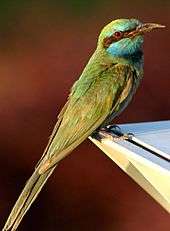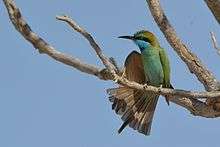Green bee-eater
| Green bee-eater | |
|---|---|
_in_Tirunelveli.jpg) | |
| ssp. orientalis | |
| Scientific classification | |
| Kingdom: | Animalia |
| Phylum: | Chordata |
| Class: | Aves |
| Order: | Coraciiformes |
| Family: | Meropidae |
| Genus: | Merops |
| Species: | M. orientalis |
| Binomial name | |
| Merops orientalis Latham, 1801 | |
| Synonyms | |
|
Merops viridis Neumann, 1910 | |
The green bee-eater (Merops orientalis) (sometimes little green bee-eater) is a near passerine bird in the bee-eater family. It is resident but prone to seasonal movements and is found widely distributed across sub-Saharan Africa from Senegal and the Gambia to Ethiopia, the Nile valley, western Arabia and Asia through India to Vietnam.[2] They are mainly insect eaters and they are found in grassland, thin scrub and forest often quite far from water. Several regional plumage variations are known and several subspecies have been named.
Description

Like other bee-eaters, this species is a richly coloured, slender bird. It is about 9 inches (16–18 cm) long with about 2 inches made up by the elongated central tail-feathers. The sexes are not visually distinguishable. The entire plumage is bright green and tinged with blue especially on the chin and throat. The crown and upper back are tinged with golden rufous. The flight feathers are rufous washed with green and tipped with blackish. A fine black line runs in front of and behind the eye. The iris is crimson and the bill is black while the legs are dark grey. The feet are weak with the three toes joined at the base.[3] Southeast Asian birds have rufous crown and face, and green underparts, whereas Arabian beludschicus has a green crown, blue face and bluish underparts. The wings are green and the beak is black. The elongated tail feathers are absent in juveniles. Sexes are alike.[2]
The calls is a nasal trill tree-tree-tree-tree, usually given in flight.[3]
Taxonomy
The green bee-eater was first described by the English ornithologist John Latham in 1801 using its current binomial name.[4] Several populations have been designated as subspecies:[5]
- viridissimus is found from Senegal to northern Ethiopia (has more green on the throat, crown and nape with long streamers)
- cleopatra from the Nile Valley to northern Sudan
- flavoviridis from northern Chad to Sudan
- muscatensis on the Arabian plateau (more yellowish green with narrow gorget on throat)
- cyanophrys found in Israel and the Arabian region (includes meccanus)
- beludschicus(=biludschicus[6]) Iran to Pakistan (paler colours with a blue throat)[7]
- orientalis in India and Sri Lanka (has head and neck tinged with rufous).
- ferrugeiceps (=birmanus) in northeastern India, Myanmar, Thailand and Vietnam (has rufous crown, name and mantle). I
- ceylonicus in Sri Lanka has the nape and hindneck with more pronounced golden brown sheen[8] often included within the nominate race
A study of species within the genus Merops based on plumage characteristics found that most of the subspecies of orientalis grouping together with the most similar species being Merops leschenaulti and subspecies ferrugeiceps appeared closer to that group.[9]
Leucistic individuals have been noted.[10]
Distribution and habitat
This is an abundant and fairly tame bird, familiar throughout its range. It is a bird which breeds in open country with bushes. In Africa and Arabia it is found in arid areas, but is more diverse in its habitats further east. This species often hunts from low perches, maybe only a metre or less high. It readily makes use of fence wires and electric wires. Unlike some other bee-eaters, they can be found well away from water.[5]

They are mostly see in the plains but can sometimes be found up to 5000 or 6000 feet in the Himalayas. They are resident in the lowlands of South Asia but some populations move seasonally but the patterns are not clear,[3] moving away to drier regions in the rainy season and to warmer regions in winter.[5] In parts of Pakistan, they are summer visitors.[11]
Behaviour and ecology
Like other species in the genus, bee-eaters predominantly eat insects, especially bees, wasps and ants, which are caught in the air by sorties from an open perch. Before swallowing prey, a bee-eater removes stings and breaks the exoskeleton of the prey by repeatedly thrashing it on the perch. Migration is not known but they make seasonal movements in response to rainfall.[2] These birds are somewhat sluggish in the mornings and may be found huddled next to each other on wires sometimes with their bills tucked in their backs well after sunrise. They sand-bathe more frequently than other bee-eater species and will sometimes bathe in water by dipping into water in flight.[5] They are usually seen in small groups and often roost communally in large numbers (200-300). The birds move excitedly at the roost site and call loudly, often explosively dispersing before settling back to the roost tree.[12] The little green bee-eater is also becoming common in urban and sub-urban neighborhoods, and has been observed perching on television antennae, only to launch into a brief, zig-zag flight formation to catch an insect, then return to the same perch and consume the meal. This behaviour is generally observed between the hours of 7:00 and 8:00am, and after 4:00pm.
_at_Sindhrot_near_Vadodara%2C_Gujrat_Pix_254.jpg)
The breeding season is from March to June. Unlike many bee-eaters, these are often solitary nesters, making a tunnel in a sandy bank. The breeding pairs are often joined by helpers.[13][14] They nest in hollows in vertical mud banks. The nest tunnel that they construct can run as much as 5 feet long and the 3-5 eggs are laid on the bare ground in the cavity at the end of the tunnel. The eggs are very spherical and glossy white.[3] Clutch size varies with rainfall and insect food density. Both sexes incubate. The eggs hatch asynchronously with an incubation period of about 14 days and the chicks grow fledge in 3 to 4 weeks and in the fledging stage show a reduction in body weight.[15][16]
A study suggested that green bee-eaters may be capable of interpreting the behaviour of human observers. They showed an ability to predict whether a human at a particular location would be capable of spotting the nest entrance and then behaved appropriately to avoid giving away the nest location. The ability to look at a situation from another's point of view was previously believed to be possessed only by primates.[17][18]
Riverside habitats were found to support high populations in southern India (157 birds per square kilometre) dropping off too 101 per km² in agricultural areas and 43-58 per square km near human habitations.[19]
They feed on flying insects and can sometimes be nuisance to bee-keepers.[20] The preferred prey was mostly beetles followed by hymenopterans. Orthopterans appear to be avoided.[21] They are sometimes known to take crabs.[22] Like most other birds they regurgitate the hard parts of their prey as pellets.[23]
An endoparasitic nematode (Torquatoides balanocephala) sometimes infects their gizzard.[24] A protozoal parasite in their blood, Haemoproteus manwelli, has been described from India.[25]
References
- ↑ BirdLife International (2012). "Merops orientalis". IUCN Red List of Threatened Species. Version 2013.2. International Union for Conservation of Nature. Retrieved 26 November 2013.
- 1 2 3 Fry, C.H.; Fry, K. (1992). Kingfishers, Bee-Eaters and Rollers. A Handbook. Princeton University Press. ISBN 0-7136-8028-8.
- 1 2 3 4 Whistler, Hugh (1949). Popular Handbook of Indian Birds. Fourth Edition. Gurney and Jackson. pp. 295–296.
- ↑ Latham, John (1801). Supplementum indicis ornithologici sive systematis ornithologiae (in Latin). London: Leigh & Sotheby. p. xxxiii.
- 1 2 3 4 Ali, S; S D Ripley (1983). Handbook of the birds of India and Pakistan. 4 (2 ed.). Oxford University Press. pp. 108–111.
- ↑ Baker, ECS (1922). "Handlist of the birds of the Indian empire". J. Bombay Nat. Hist. Soc. 28 (2): 141.
- ↑ Nurse,CG (1904). "Occurrence of the Common Indian Bee-eater Merops viridis in Baluchistan.". J. Bombay Nat. Hist. Soc. 15 (3): 530–531.
- ↑ Rasmussen PC; JC Anderton (2005). Birds of South Asia: The Ripley Guide. 2. Smithsonian Institution and Lynx Edicions. pp. 268–269.
- ↑ Burt, D Brent (2004). "Plumage-based phylogenetic analyses of the Merops bee-eaters" (PDF). Ibis. 146: 481–492. doi:10.1111/j.1474-919x.2004.00289.x.
- ↑ Whistler,H (1919). "Abnormal variety of the Green Bee-eater Merops viridis". J. Bombay Nat. Hist. Soc. 26 (3): 844.
- ↑ Dewar, Douglas (1906). "A Note on the Migration of the Common Indian Bee-eater (Merops viridis).". J. Bombay Nat. Hist. Soc. 17 (2): 520–522.
- ↑ Bastawde,DB (1976). "The roosting habits of Green Bee-eater Merops orientalis orientalis Latham.". J. Bombay Nat. Hist. Soc. 73 (1): 215.
- ↑ Burt, D. Brent (2002). "Social and Breeding Biology of Bee-eaters in Thailand." (PDF). Wilson Bull. 114 (2): 275–279. doi:10.1676/0043-5643(2002)114[0275:SABBOB]2.0.CO;2.
- ↑ Sridhar, S.; K. Praveen Karanth (1993). "Helpers in cooperatively breeding Small Green Bee-eaters (Merops orientalis)." (PDF). Curr. Sci. (Bangalore). 65: 489–490.
- ↑ Asokan S; Ali AMS;Manikannan R & P. Radhakrishnan (2009). "Observations on Nest-sites, Eggs and Nestling Growth Patterns of the Small Bee-eater Merops orientalis L. in India" (PDF). World Journal of Zoology. 4 (3): 163–168.
- ↑ Asokan, S., A.M.S. Ali & R. Manikannan (2010). "Breeding biology of the Small Bee-eater Merops orientalis (Latham, 1801) in Nagapattinam District, Tamil Nadu, India". Journal of Threatened Taxa. 2 (4): 797–804. doi:10.11609/jott.o2273.797-804.
- ↑ Watve Milind, Thakar J, Kale A, Pitambekar S. Shaikh I Vaze K, Jog M. Paranjape S. (2002). "Bee-eaters ( Merops orientalis) respond to what a predator can see". Animal Cognition. 5 (4): 253–9. doi:10.1007/s10071-002-0155-6. PMID 12461603.
- ↑ Smitha, B., Thakar, J. & Watve, M. (1999). "Do bee eaters have theory of mind?". Current Science. 76: 574–577.
- ↑ Asokan, S., Thiyagesan, K., Nagarajan, R., Kanakasabai, R. (2003). "Studies on Merops orientalis latham 1801 with special reference to its population in Mayiladuthurai, Tamil Nadu.". Journal of Environmental Biology. 24 (4): 477–482. PMID 15248666.
- ↑ Sihag, R.C. (1993). "The green bee-eater Merops orientalis orientalis latham - (1) - Seasonal activity, population density, feeding capacity and bee capture efficiency in the apiary of honey bee, Apis mellifera L. in Haryana(India).". Korean Journal of Apiculture. 8 (1): 5–9.
- ↑ Asokan, S (1998). "Food and feeding habits of the small green bee - eater Merops orientalis in Mayiladuthurai.". Journal of Ecobiology. 10 (3): 199–204.
- ↑ Khacher,Lavkumar (1995). "Little Green Bee-eater, Merops orientalis Latham feeding on crabs.". J. Bombay Nat. Hist. Soc. 92 (1): 121.
- ↑ Santharam,V (1981). "Pellet casting by Bee-eaters.". Newsletter for Birdwatchers. 21 (12): 18.
- ↑ Nandi, A. P. (2007). "Scanning electron microscope study of two avian nematodes: Ascaridia trilabium (Linstaw, 1904) and Torquatoides balanocephala (Gendre, 1922)" (PDF). Journal of Parasitic Diseases. 31 (2): 103–107.
- ↑ Bennett, Gordon F. (1978). "Avian Haemoproteidae. 8. The haemoproteids of the bee-eater family (Meropidae)". Canadian Journal of Zoology. 56 (8): 1721. doi:10.1139/z78-236.
External links
| Wikimedia Commons has media related to Green bee-eater. |
| Wikispecies has information related to: Merops orientalis |

